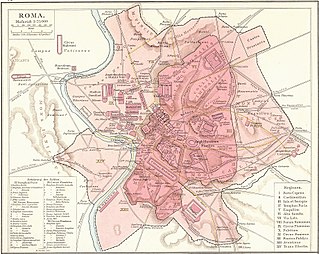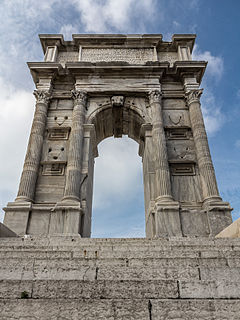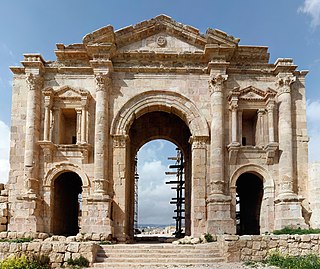Description
The arch reaches a height of 12 metres, with a central arch of 6 metres in height which permitted the passage of vehicles that have left deep ruts in the ground under the archway. The lateral arches, each 3.75 metres high, were reserved for pedestrians.
Above the lateral arches on both sides are deep rectangular niches, which are flanked by aediculae with smooth-stemmed Corinthian columns of coloured marble on shelves. The niches were designed to hold statues, which are now lost. The whole assemblage of each lateral arch and niche was framed by two red Corinthian columns, detached from the walls and supported by pedestals. The entablature that runs across the wall above the lateral arches protrudes above the columns, and a curvilinear pediment rests on it in turn. The attic must have been surmounted with a group of monumental statues.
Other sculpture was added to the arch in later times. This includes a statue of the gods Mars and one of Concordia erected under Emperor Septimius Severus by Lucius Licinius Optatianus, on the occasion of his election as flamen-for-life of the colonia. [3]

In ancient Roman religion, an aedicula is a small shrine, and in classical architecture refers to a niche covered by a pediment or entablature supported by a pair of columns and typically framing a statue. Aediculae are also represented in art as a form of ornamentation. The word aedicula is the diminutive of the Latin aedes, a temple building or dwelling place. The Latin word has been Anglicised as "aedicule" and as "edicule".

Trajan's Column is a Roman triumphal column in Rome, Italy, that commemorates Roman emperor Trajan's victory in the Dacian Wars. It was probably constructed under the supervision of the architect Apollodorus of Damascus at the order of the Roman Senate. It is located in Trajan's Forum, north of the Roman Forum. Completed in AD 113, the freestanding column is most famous for its spiral bas relief, which depicts the wars between the Romans and Dacians. Its design has inspired numerous victory columns, both ancient and modern.

A triumphal arch is a free-standing monumental structure in the shape of an archway with one or more arched passageways, often designed to span a road. In its simplest form a triumphal arch consists of two massive piers connected by an arch, crowned with a flat entablature or attic on which a statue might be mounted or which bears commemorative inscriptions. The main structure is often decorated with carvings, sculpted reliefs, and dedications. More elaborate triumphal arches may have multiple archways.

Timgad was a Roman city in the Aurès Mountains of Algeria. It was founded by the Roman Emperor Trajan around CE 100. The full name of the city was Colonia Marciana Ulpia Traiana Thamugadi. Emperor Trajan named the city in commemoration of his mother Marcia, eldest sister Ulpia Marciana, and father Marcus Ulpius Traianus.

The Arch of Constantine is a triumphal arch in Rome dedicated to the emperor Constantine the Great. The arch was commissioned by the Roman Senate to commemorate Constantine's victory over Maxentius at the Battle of Milvian Bridge in AD 312. Situated between the Colosseum and the Palatine Hill, the arch spans the Via triumphalis, the route taken by victorious military leaders when they entered the city in a triumphal procession. Dedicated in 315, it is the largest Roman triumphal arch, with overall dimensions of 21 m (69 ft) high, 25.9 m (85 ft) wide and 7.4 m (24 ft) deep. It has three bays, the central one being 11.5 m (38 ft) high and 6.5 m (21 ft) wide and the laterals 7.4 m (24 ft) by 3.4 m (11 ft) each. The arch is constructed of brick-faced concrete covered in marble.

The Arch of Septimius Severus at the northeastern end of the Roman Forum is a white marble triumphal arch dedicated in 203 A.D. to commemorate the Parthian victories of Emperor Septimius Severus and his two sons, Caracalla and Geta, in the two campaigns against the Parthians of 194-195 A.D. and 197–199 A.D. After the death of Septimius Severus, his sons Caracalla and Geta were initially joint emperors. Caracalla had Geta assassinated in 212 A.D.; Geta's memorials were destroyed and all images or mentions of him were removed from public buildings and monuments. Accordingly, Geta's image and inscriptions referring to him were removed from the arch.

Ulpia Marciana was the beloved elder sister of Roman Emperor Trajan.

The Arch of Hadrian, most commonly known in Greek as Hadrian's Gate, is a monumental gateway resembling—in some respects—a Roman triumphal arch. It spanned an ancient road from the center of Athens, Greece, to the complex of structures on the eastern side of the city that included the Temple of Olympian Zeus.

The Column of Marcus Aurelius is a Roman victory column in Piazza Colonna, Rome, Italy. It is a Doric column featuring a spiral relief: it was built in honour of Roman emperor Marcus Aurelius and modeled on Trajan's Column.

The Arch of Trajan is an ancient Roman triumphal arch in Benevento, southern Italy. It was erected in honour of the Emperor Trajan across the Via Appia, at the point where it enters the city.

The Arch of Trajan in Ancona is a Roman triumphal arch erected in 115 by the Senate and people of Rome in the reign of Emperor Trajan. It was built in honour of that Emperor after he expanded the port of the city out of his own pocket, improving the docks and the fortifications. It was from here that Trajan departed for the ultimately successful war against the Dacians, an episode which is commemorated in the bas relief of Trajan's column in Rome.

The Arch of Augustus was the triumphal arch of Augustus, located in the Roman Forum. It spanned the Via Sacra, between the Temple of Castor and Pollux and the Temple of Caesar, near the Temple of Vesta, closing off the eastern end of the Forum. It can be regarded as the first permanent three-bayed arch ever built in Rome.

Forum of Nerva is an ancient structure in Rome, Italy, chronologically the next to the last of the Imperial fora built.

The Arch of Caracalla is a Roman triumphal arch located at Djémila in Algeria (Cuicul). It was built during the early 3rd century. The arch, with a single span (fornix), was placed on the road leading to Sitifis. It constituted the entrance to the city's Severan forum.

The Arch of Caracalla is a tetrapylon Roman triumphal arch in Thebeste, located in present-day Tébessa, Tébessa Province, Algeria. It was constructed during the early 3rd century.

The Arch of Hadrian is an ancient Roman triumphal arch located in Santa Maria Capua Vetere. It was originally a triple arch, but today only three pylons and one of the lateral arches survive. It spanned the Appian Way and constituted an ideal entrance to the city, perhaps corresponding to the line of the pomerium.

The Arch of Alexander Severus is a Roman triumphal arch in the ancient civitas of Thugga, located in Dougga, Béja, Tunisia. It was dedicated to the Roman Emperor Alexander Severus.

The Arch of Hadrian is an ancient Roman structure in Jerash, Jordan. It is an 11-metre high triple-arched gateway erected to honor the visit of Roman Emperor Hadrian to the city in the winter of 129–130. The arch originally stood to almost 22 m and probably had wooden doors. It features some unconventional, possibly Nabataean, architectural features, such as acanthus bases. The columns are decorated with capitals at the bottom rather than the top. The monument served both as a commemorative arch and as an approach to Gerasa. The Arch's relative remoteness from the city walls points to a plan for southward expansion of Gerasa during its heyday. The expansion, however, has not been implemented.

The Arch of Septimius Severus is a triumphal arch in Leptis Magna, located in present-day Libya. It was commissioned by the Libya-born Roman Emperor Septimius Severus. The arch was in ruins but was pieced back together by archeologists after its discovery in 1928.

The Basilica di San Francesco is a Gothic-style, Roman Catholic church located on the Piazza del Popolo in the town of Ascoli Piceno in the region of Marche, Italy.




















